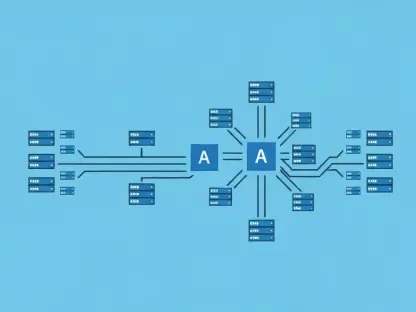Creating a successful app similar to Qiwa in Saudi Arabia necessitates a well-rounded approach that integrates understanding the local market, following rigorous regulations, and harnessing the most effective technologies. The comprehensive nature of this process requires detailed planning and meticulous execution to ensure that the desired outcomes are achieved seamlessly. This article serves as a holistic guide to navigate the intricacies involved in developing an app that can emulate the success of Qiwa in the Saudi Arabian market.
Understanding Vision 2030 and Digital Transformation
Saudi Arabia’s Vision 2030 is a pivotal initiative that seeks to transform the country into a digitally advanced society where government services are seamlessly accessible through digital means. This ambitious vision underscores the importance of modernizing various facets of government operations, thereby enhancing their efficiency and accessibility. Qiwa, a flagship project under this initiative, exemplifies the successful digital shift by streamlining labor market processes, benefiting both employers and employees significantly.
Qiwa provides a comprehensive platform that simplifies numerous labor market processes such as employment contracts, visa services, and workforce management. This digital transformation is an essential context to understand for anyone aiming to develop a similar app in Saudi Arabia. The goal is to create a platform that aligns with the national vision, thereby contributing to the overarching aim of modernizing government services. By understanding and aligning with this vision, developers can ensure that their app not only meets user needs but also adheres to the strategic objectives of the nation.
Assessing the Cost of Development
Developing an app analogous to Qiwa constitutes a significant financial undertaking, with costs generally ranging from SAR 135,000 to SAR 2,500,000, depending on the complexity and feature set desired. For an app at the simple end of the spectrum, characterized by basic functionalities, the cost can range from SAR 135,000 to SAR 400,000. This would typically cover the creation of a minimal viable product (MVP) with essential features.
Moving towards a medium-level app, which includes additional features, administrative controls, and improved scalability, the cost ascends to around SAR 400,000 to SAR 900,000. Such an app would offer a more polished user experience, catering to a broader audience with enhanced functionalities. On the higher end, developing an advanced app with AI-driven features, complex security measures, and large-scale integrations can exceed SAR 2,500,000. This level of investment ensures robust performance, security, and user engagement for a highly sophisticated platform.
Hidden Costs to Consider
While the primary development costs are substantial, several hidden costs can significantly impact the overall budget. Regulatory compliance constitutes a major hidden cost, necessitating legal consultations and certifications to ensure adherence to Saudi labor laws and data protection regulations. These costs are vital to avoid legal pitfalls and ensure the app operates within the legal framework of the country.
Another recurring expense is the cloud infrastructure. Reliable cloud providers such as AWS, Azure, or Google Cloud incur costs for server uptime, storage, and security management. These services are crucial for maintaining the app’s performance and security. In addition to these, continuous updates and maintenance can add 15-25% of the initial development cost annually, ensuring the app remains functional and up-to-date.
Third-party integrations also involve additional costs, including licensing or transaction fees for services like Absher authentication and various payment gateways. Moreover, cybersecurity investments are indispensable, necessitating regular security audits, penetration testing, and advanced encryption measures to safeguard sensitive employee and business data against potential breaches.
Critical Factors Affecting Development Costs
Several critical factors influence the development costs associated with creating an app similar to Qiwa. The complexity of the app is a prime determinant; more intricate applications with advanced functionalities, automation, and integration capabilities tend to incur higher development expenses. For a sophisticated platform, these technical elements are essential but can significantly drive up the cost.
User experience is another pivotal factor. High-quality UI/UX design is integral to ensuring user engagement and efficiency, but it also adds to the development expenditure. Ensuring a seamless and intuitive user interface requires considerable investment in both design and testing phases. Additionally, ensuring the app’s scalability to handle increasing user and data loads is crucial, further impacting the overall cost.
Compliance and security are non-negotiable aspects that can also inflate costs. Adhering to local regulations and implementing rigorous data protection measures are essential to ensure the app’s legality and user trust. Investing in robust security features, including encryption and regular security audits, adds to the initial development and ongoing maintenance costs, ensuring the app’s integrity over time.
Essential Features of an App Like Qiwa
For an app similar to Qiwa, several key features are indispensable for both employers and employees. For employers, crucial features include business registration, access to a range of government services, financial services access, comprehensive employee management tools, and training and development programs. These functionalities collectively streamline business operations, making it easier for employers to manage their workforce effectively.
Employees also benefit from a suite of essential features. These include employment status verification, work permit management, and career management tools, which simplify navigating the labor market. Additionally, the app should incorporate tools and calculators, such as the Nitaqat calculator, end-of-service reward calculator, certificate validation, and work permit calculator, to offer comprehensive support and assistance. These tools are designed to provide users with valuable insights and aid in their decision-making processes.
Design Considerations for Success
A successful app must prioritize simplicity and clarity in design. Adopting a minimalist approach with clear, structured interfaces ensures ease of use and enhances user experience. Another vital consideration is localization and bilingual support to cater to both Arabic and English-speaking users. This not only involves providing content in both languages but also includes aligning text properly for right-to-left languages like Arabic.
Intuitive navigation is essential for user engagement. A dashboard-first approach can be particularly effective, providing easy access to the most relevant information at a glance. Additionally, adopting a mobile-first approach is crucial given the high smartphone penetration in Saudi Arabia. Ensuring the app is fully responsive and optimized for mobile devices enhances its usability and accessibility.
Other important design considerations include integrating smart automation and AI-driven features to guide users through various processes, enhancing overall efficiency. Security-driven UI elements such as biometric authentication and real-time login alerts are also essential in today’s digital landscape, ensuring that users feel safe and secure while using the app.
Technology Stack for Development
Choosing the appropriate technology stack is pivotal for the successful development of an app like Qiwa. For the frontend, technologies such as React.js, Vue.js, and Next.js are suitable for web applications, while Flutter, Swift, Kotlin, and React Native are ideal for mobile applications. These technologies offer the flexibility and performance needed to create a seamless user experience.
For the backend, employing robust programming languages and frameworks such as Node.js with Express.js, Django (Python), and Spring Boot (Java) is recommended. These technologies provide the necessary infrastructure to handle complex functionalities and large-scale user interactions. Databases like PostgreSQL, MongoDB, and Redis are also essential for efficient data management and retrieval.
In addition to these, utilizing UI frameworks such as Bootstrap, Tailwind CSS, Figma, and Adobe XD can enhance the app’s design and user interface. These tools help create visually appealing and user-friendly designs, ensuring the app remains engaging and intuitive for users across various devices and platforms.
Cloud and Infrastructure Considerations
Relying on robust cloud platforms is essential for creating a scalable and reliable infrastructure. Platforms like AWS, Microsoft Azure, and Google Cloud Platform offer the necessary tools and services to support the app’s backend operations efficiently. Employing server and deployment tools such as Docker, Kubernetes, NGINX, and Apache can further streamline the development process, facilitating continuous integration and continuous deployment (CI/CD) practices.
For storage and document management, solutions like Amazon S3, Azure Blob Storage, and blockchain integration are highly effective. These services provide secure and scalable storage options, ensuring the app can handle large volumes of data and documents without compromising performance. Additionally, integrating with government APIs such as Absher API, Muqeem API, and HRSD API is crucial for providing essential services and functionalities.
By leveraging these advanced cloud and infrastructure technologies, developers can ensure that the app remains robust, scalable, and efficient, capable of meeting the demands of a growing user base and evolving business needs.
Best Practices to Optimize Development Costs
Optimizing development costs is crucial for ensuring the project remains financially viable. One effective strategy is to develop a Minimal Viable Product (MVP) initially. This approach allows for the launch of a version of the app with essential features, enabling developers to test market demand and gather valuable user feedback. Based on this feedback, the app can be further refined and expanded, ensuring resources are allocated efficiently.
Prioritizing core features initially and gradually introducing additional functionalities based on user feedback can also help manage costs. Leveraging open-source technologies is another strategy to reduce expenses significantly. Open-source tools and frameworks provide robust functionalities without the associated licensing fees, making them cost-effective options for development.
Hiring a dedicated development team ensures that resources are used efficiently and that the project stays on track. Additionally, opting for cross-platform development using frameworks like Flutter or React Native can reduce both development and maintenance costs by enabling the app to run seamlessly on multiple platforms with a single codebase. Following agile development practices facilitates iterative development, allowing developers to adapt to changing requirements swiftly and efficiently.
Monetization Strategies
Effective monetization strategies are essential for generating revenue and ensuring the app’s long-term viability. A subscription-based model with tiered plans for premium services is a popular approach. This model allows users to access basic features for free, while advanced functionalities are available through paid subscriptions, ensuring a steady stream of revenue.
Another viable strategy is the freemium model, which offers essential services for free while charging for upgrades to more advanced features. In-app advertisements can also generate additional revenue, particularly if they are targeted and relevant to the user base. Charging a listing fee or commission for successful hires and partnering with consulting firms for lead generation can further enhance revenue streams.
API access and data monetization offer additional opportunities. By providing API access to third-party businesses and monetizing anonymized data, developers can create new revenue channels. Implementing a pay-per-service model for specific features or functionalities and securing corporate partnerships and sponsorships also contribute to a diversified revenue strategy.
Gaining a Competitive Edge Over Qiwa
To succeed in a competitive landscape, it’s essential to offer unique value propositions that distinguish your app from others, including Qiwa. One way to achieve this is by focusing on providing an enhanced user experience through simplified navigation and customization options. Streamlining the user interface ensures that users can find and use features easily, thus improving overall engagement and satisfaction.
Emphasizing advanced automation and AI-driven functionalities can also set your app apart. Automating repetitive tasks and leveraging AI for predictive analytics enables more efficient and personalized user interactions. Additionally, offering specialized features tailored to the needs of small businesses can attract a niche audience, providing tools and functionalities that facilitate their unique requirements.
Seamless integration with other platforms, such as HR software, payroll systems, and CRM solutions, enhances the app’s utility, making it a more comprehensive solution for businesses. Expanding access to additional government services and providing real-time support through 24/7 live chat, AI-driven assistants, and expert support further differentiates your app. Incorporating feedback for continuous improvement ensures that the app evolves to meet user needs, maintaining its relevance and competitiveness in the market.
Final Thoughts
Creating a successful app similar to Qiwa in Saudi Arabia requires a well-rounded approach that includes understanding the local market, adhering to strict regulations, and leveraging the most effective technologies available. This comprehensive process demands detailed planning and careful execution to ensure that the desired results are achieved without any hiccups. A fundamental aspect of this endeavor is to thoroughly research and understand the unique needs and preferences of the Saudi Arabian audience. This includes familiarizing yourself with cultural nuances, user behavior, and market trends that can influence the app’s adoption and success.
Moreover, staying compliant with local laws and regulations is essential. Saudi Arabia has specific guidelines for digital products, which must be meticulously followed to avoid legal repercussions. Partnering with local legal advisors can be invaluable in navigating these complexities.
In addition to market research and legal compliance, leveraging cutting-edge technologies is crucial. This not only enhances the app’s functionality but also ensures it offers a seamless user experience. Employing best practices in design, development, and user testing can significantly improve the app’s performance and user satisfaction.
This article aims to serve as a comprehensive guide, helping you navigate the complexities involved in developing an app that can achieve similar success as Qiwa in the Saudi Arabian market. By focusing on these key elements, you can create a robust and highly effective app tailored to meet the needs and expectations of Saudi users.









